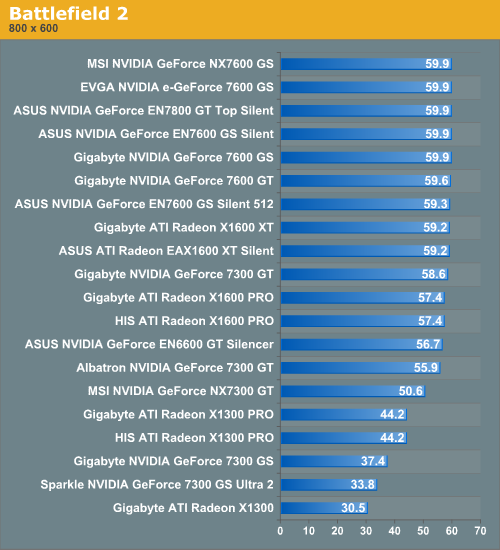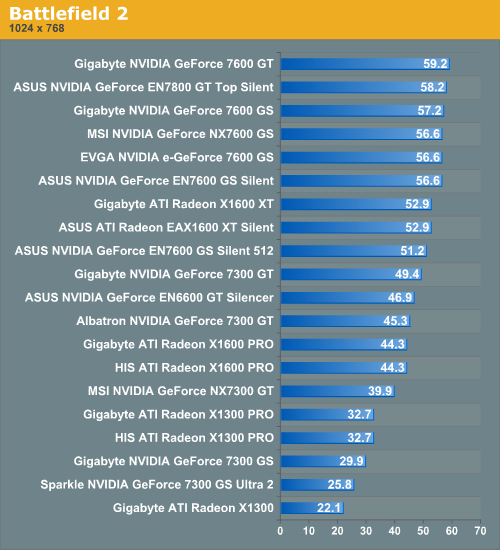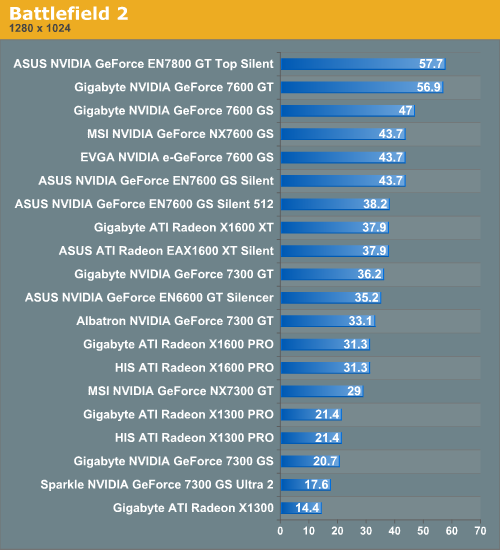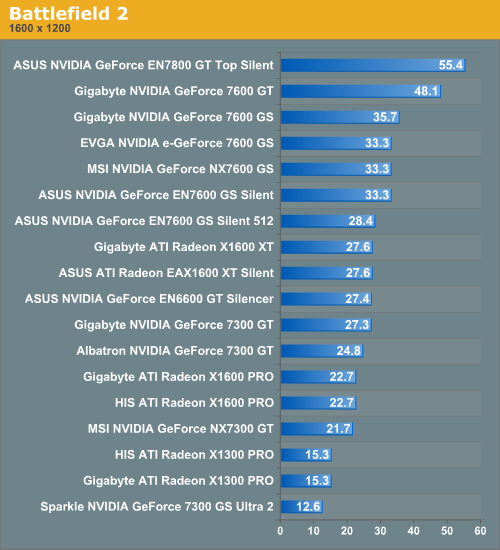Battlefield 2
Battlefield 2 is a game that has been a valuable asset to our GPU testing, and it's one of our absolute standards for present-day gaming. The game is one of the most popular that we test, and it is still one of the best reasons to upgrade your graphics card. Our benchmark for this game is basically a third-person view of a player on foot and in a few different vehicles, including a jet. This gives us a wide view of the action in the different vehicles and on foot in order to get a test which covers a wide range of gameplay. We tested Battlefield 2 with the graphics settings on "High" quality.




When testing Battlefield 2, we noticed a strange graphical issue with our 7300 GS cards, the Sparkle 7300 GS Ultra 2 and the Gigabyte 7300 GS. For some reason, ground textures show up as white (blank) when in third-person view, and strange motion trails follow the characters and vehicles (as well as some structures). We're not sure why this happens (it's possibly a TurboCache issue, as these cards use this technology), but there aren't any graphical problems when in first-person mode. This will be a significant inconvenience for any BF2 players who like using third-person view (as this editor does) when in certain vehicles like the hum-vee.
A pattern we will see throughout all of these tests is that the ASUS EN7800 GT Top Silent will stand out as the highest performer, particularly in the higher resolutions. This is the advantage of a part that has a higher number of pixel pipelines (20) and is a higher-end part in general. However, with the extra performance comes a higher price tag and higher temperatures, and this silent 7800 GT from ASUS is hard to find on sale at the time of this writing. (MSI also manufactures a silent 7900 GT card which would further improve performance, although unfortunately it is apparently only available in European markets.)
In the graphs above, the first thing we notice is an overhead of about 60 fps at the lowest resolution for a lot of the cards. The game runs well on most of the cards at this setting, and even the slowest cards can run the game at a playable frame rate. Because things like sniping are part of the game play in Battlefield 2, 800x600 is not an ideal resolution unless you are only playing on the smallest maps. 1024x768 is more suitable for medium to large games, so this is something to consider while looking at performance.
We can see that on the low end, the X1300 performs worse that the Sparkle 7300 GS up until you get to the higher resolution. This isn't helpful though because none of these cards are really playable over 1024x768. If you want to be able to play Battlefield 2 at 1600x1200 on "high" quality, you will probably need at least an X1600 XT to do so.
As a side note, we can see how the factory overclocks on cards like the Gigabyte and Albatron 7300 GT and Gigabyte 7600 GS give a few extra frames of performance over the other cards of the same type. Cards like these will naturally have a slight edge in performance over the reference clocked ones which is always something to consider when looking at card prices.
Battlefield 2 is a game that has been a valuable asset to our GPU testing, and it's one of our absolute standards for present-day gaming. The game is one of the most popular that we test, and it is still one of the best reasons to upgrade your graphics card. Our benchmark for this game is basically a third-person view of a player on foot and in a few different vehicles, including a jet. This gives us a wide view of the action in the different vehicles and on foot in order to get a test which covers a wide range of gameplay. We tested Battlefield 2 with the graphics settings on "High" quality.




When testing Battlefield 2, we noticed a strange graphical issue with our 7300 GS cards, the Sparkle 7300 GS Ultra 2 and the Gigabyte 7300 GS. For some reason, ground textures show up as white (blank) when in third-person view, and strange motion trails follow the characters and vehicles (as well as some structures). We're not sure why this happens (it's possibly a TurboCache issue, as these cards use this technology), but there aren't any graphical problems when in first-person mode. This will be a significant inconvenience for any BF2 players who like using third-person view (as this editor does) when in certain vehicles like the hum-vee.
A pattern we will see throughout all of these tests is that the ASUS EN7800 GT Top Silent will stand out as the highest performer, particularly in the higher resolutions. This is the advantage of a part that has a higher number of pixel pipelines (20) and is a higher-end part in general. However, with the extra performance comes a higher price tag and higher temperatures, and this silent 7800 GT from ASUS is hard to find on sale at the time of this writing. (MSI also manufactures a silent 7900 GT card which would further improve performance, although unfortunately it is apparently only available in European markets.)
In the graphs above, the first thing we notice is an overhead of about 60 fps at the lowest resolution for a lot of the cards. The game runs well on most of the cards at this setting, and even the slowest cards can run the game at a playable frame rate. Because things like sniping are part of the game play in Battlefield 2, 800x600 is not an ideal resolution unless you are only playing on the smallest maps. 1024x768 is more suitable for medium to large games, so this is something to consider while looking at performance.
We can see that on the low end, the X1300 performs worse that the Sparkle 7300 GS up until you get to the higher resolution. This isn't helpful though because none of these cards are really playable over 1024x768. If you want to be able to play Battlefield 2 at 1600x1200 on "high" quality, you will probably need at least an X1600 XT to do so.
As a side note, we can see how the factory overclocks on cards like the Gigabyte and Albatron 7300 GT and Gigabyte 7600 GS give a few extra frames of performance over the other cards of the same type. Cards like these will naturally have a slight edge in performance over the reference clocked ones which is always something to consider when looking at card prices.










49 Comments
View All Comments
Josh Venning - Thursday, August 31, 2006 - link
I also forgot to mention that some people use their pcs in home theater systems as well. This would be another case when you want as little noise from your computer as possible.imaheadcase - Thursday, August 31, 2006 - link
That was not always the case, my 9700 Pro i still use when fan went out a year ago, works like a charm without it on. It was in its time the high end card, lets hope those days come buy again :Deckre - Thursday, August 31, 2006 - link
What a great review, when tom did their silent VC review, they included a grand total of three cards...pfft. nice job anand.I have the 7600GT, very sweet and 0dB is oh so nice.
Josh Venning - Thursday, August 31, 2006 - link
We just wanted to say thanks all for your comments and we are still trying to make sure we've caught any errors. (there are actually only 20 cards in the roundup and not 21) As Derek said, these cards were included in the article because we requested any and all silent cards that any of the manufacturers were willing to give us to review. That's also why we have more cards from ASUS and Gigabyte than the others.Olaf van der Spek - Thursday, August 31, 2006 - link
Because the videocard industry hasn't introduced such a bad design as the netburst architecture.
epsilonparadox - Thursday, August 31, 2006 - link
No they've introduced worse. When they recommend a second PS just for grafx or even a 1Kw single PS, they've taken intel's lack of thermal control to a whole new level.DerekWilson - Thursday, August 31, 2006 - link
graphics cards use much much less power in 2d mode than in 3d mode -- and even their 3d power saving capabilities are really good.this is especially true when you consider the ammount of processing power a GPU delivers compared to a CPU.
Theoretical peak performance of a current desktop CPU is in the 10-15 GFLOPS range at best. For a GPU, theoretical peak performance is at least one order of magnitude larger reaching up over 200 GFLOPS in high end cases.
I'm not saying we can reach these theoretical peak rates on either a CPU or a GPU, but a GPU is doing much much more work under load than a CPU possibly could.
Keep in mind we aren't even up to GHz on GPU cores. On the CPU front, Intel just shortened the pipeline and decreased clock speeds to save power -- doing more work in one cycle. This is absolutely what a GPU does.
And the icing on the cake is the sheer options on the silent GPU front. Neither AMD nor Intel make a fast desktop CPU that can be (easily) passively cooled. These parts are a testiment to the efficiency of the GPU.
On the flip side, ATI and NVIDIA push their high end parts way up in clock speed and power consumption trying as hard as possible to gain the performance crown.
There are plenty of reasons GPUs draw more power than a CPU under load, but a lack of thermal control or inefficient desing is not one of them. It's about die size, transistor count, and total ammount of work being done.
JarredWalton - Saturday, September 2, 2006 - link
I disagree with Derek, at least in some regards. The budget and midrange GPUs generally do a good job at throttling down power requirements in 2D mode. The high-end parts fail miserably in my experience. Sure, they consume a lot less power than they do in 3D mode, but all you have to do is look at the difference between using a Radeon Mobility X1400 and a GeForce Go 7800 in the Dell laptops to http://www.anandtech.com/mobile/showdoc.aspx?i=276...">see the difference in battery life.In 2D mode, graphics chips still consume a ton of power relatively speaking -- probably a lot of that going to the memory as well. A lot of this can be blamed on transistor counts and die size, but I certainly think that NVIDIA and ATI could reduce power more. The problem right now is that power use is a secondary consideration, and ATI and NVIDIA both need to have a paradigm shift similar to what Intel had with the Pentium M. If they could put a lot of resources into designing a fast but much less power-hungry GPU, I'm sure they could cut power draw quite a bit in both idle and load situations.
That's really the crux of the problem though: resources. Neither company has anywhere near the resources that AMD has, let alone the resources that Intel has. Process technology is at least a year behind Intel if not more, chip layouts are mostly computer generated as opposed to being tweaked manually (I think), and none of the companies have really started at square one trying to create a power efficient design; that always seems to be tacked on after-the-fact.
GPUs definitely do a lot of work, although GFLOPS is a terrible measure performance. The highly parallel nature of 3D rendering does allow you to scale performance very easily, but power requirements also scale almost linearly with performance when using the same architecture. It would be nice to see some balance between performance scaling and power requirements... I am gravely concerned about what Windows Vista is going to do for battery life on laptops, at least if you enable the Aero Glass interface. Faster switching to low-power states (for both memory and GPU) ought to be high on the list for next-generation GPUs.
DaveLessnau - Thursday, August 31, 2006 - link
I'm wondering why Anandtech tested Asus' EN7800 GT card instead of their EN7600 GT. That card would be more in line with Gigabyte's 7600 GT version and, I believe, is more available than the 7800 version. In the near future, I'd like to buy one of these silent 7600GTs and was hoping this review would help. Oh, well.DerekWilson - Thursday, August 31, 2006 - link
you can get a really good idea of how it would perform by looking at Gigabyte's card.as I mentioned elsewhere in the comments, we requested all the silent cards manufacturers could provide. if we don't have it, it is likely because they were unable to get us the card in time for inclusion in this review.